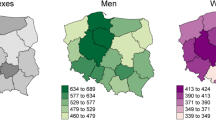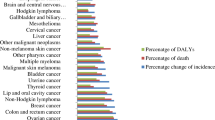Abstract
Data collected by the Cancer Registry of the Swiss Canton of Vaud (whose population in 1980 was about 530,000 inhabitants) were used to estimate the incidence of second metachronous primary cancers following any specific neoplasm. Among 34,615 cases of incident neoplasms registered between 1974 and 1989 and followed through integrated active follow-up to the end of 1989, for a total of 118,241 person-years at risk, there were 2,185 second primaries (1,280 males, 905 females). For both sexes, the standardised incidence ratios (SIR) were significantly elevated by about 20%. Overall significantly elevated ratios were registered for cancers of the oral cavity and pharynx (SIR = 1.6 for males, 2.0 for females), oesophagus in males (SIR = 1.5), lung in males (SIR = 1.4), skin melanoma (SIR = 1.7 for males, 1.5 for females), non-melanomatous skin cancers (SIR = 1.6 for males, 1.5 for females), female breast (SIR = 1.3), kidney (SIR = 1.5 for males, 1.9 for females), and thyroid in males (SIR = 2.4). When specific first cancer sites were considered, the SIR following a cancer of the oral cavity and pharynx was around 3 in both sexes, mainly on account of a substantial excess of second primaries of the oral cavity, oesophagus, larynx and lung. The overall SIR following laryngeal cancer was 3.0, and significant excesses were observed for oral cavity and pharynx, oesophagus and lung. After lung cancer, the overall SIR was 1.7 for males and 2.6 for females, and significantly elevated SIRs were observed for oral cavity, lung and oesophagus. Following non-melanomatous skin cancers, elevated SIRs were observed in both sexes for skin melanoma and non-melanomas. The incidence of any cancer after breast cancer was significantly elevated (SIR = 1.2), mainly on account of an elevated risk of subsequent breast cancer (SIR = 1.7). With reference to cervical cancer, there was a significant excess for any subsequent primary (SIR = 1.6), and for lung cancer (SIR = 7.8). Significantly elevated SIRs were observed for kidney following bladder cancer, and for bladder after kidney cancer. In both sexes, the incidence of cancers of any site was elevated following leukaemias (SIR = 1.7 for males, 2.5 for females), and a significant excess was registered for lung in males and non-melanomatous skin cancers in both sexes.(ABSTRACT TRUNCATED AT 400 WORDS)
This is a preview of subscription content, access via your institution
Access options
Subscribe to this journal
Receive 24 print issues and online access
$259.00 per year
only $10.79 per issue
Buy this article
- Purchase on Springer Link
- Instant access to full article PDF
Prices may be subject to local taxes which are calculated during checkout
Similar content being viewed by others
Author information
Authors and Affiliations
Rights and permissions
About this article
Cite this article
Levi, F., Randimbison, L., Te, VC. et al. Multiple primary cancers in the Vaud Cancer Registry, Switzerland, 1974-89. Br J Cancer 67, 391–395 (1993). https://doi.org/10.1038/bjc.1993.72
Issue Date:
DOI: https://doi.org/10.1038/bjc.1993.72
This article is cited by
-
The relative risk of second primary cancers in Switzerland: a population-based retrospective cohort study
BMC Cancer (2020)
-
The association between breast cancer and thyroid cancer: a meta-analysis
Breast Cancer Research and Treatment (2015)
-
An Uncommon Presentation of a Metachronous Primary Gastric Tumor in a Patient with a Resected Colorectal Carcinoma: Case Report and Review of the Literature
Journal of Gastrointestinal Cancer (2015)
-
The effect of patient characteristics on second primary cancer risk in France
BMC Cancer (2014)
-
Incidence of second sarcomas: a cancer registry-based study
Cancer Causes & Control (2014)



